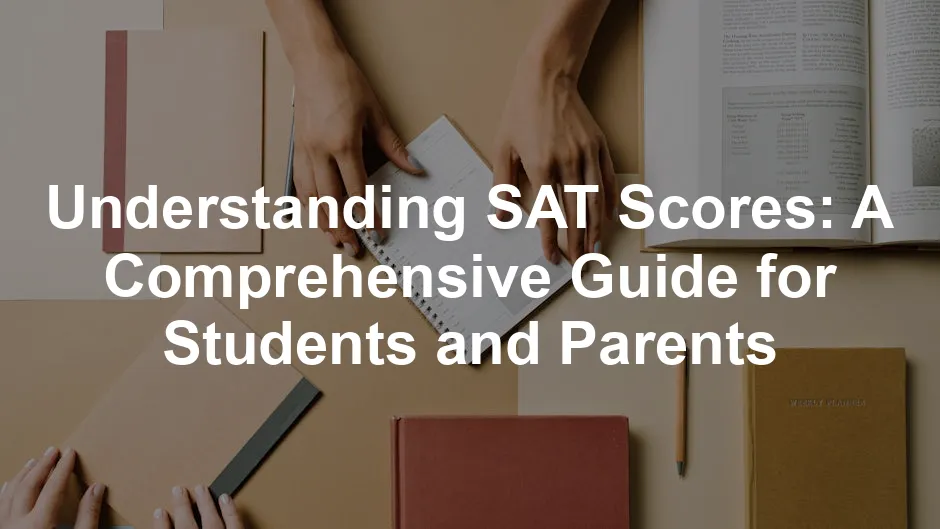Introduction
The SAT is a key player in college admissions. It’s a standardized test that colleges use to assess student readiness for higher education. Your SAT score can significantly influence your chances of getting accepted. This article will guide you through score interpretations and what constitutes a good SAT score.
To help you prepare effectively, consider picking up the SAT Prep Black Book: The Most Effective SAT Strategy Book. This book offers invaluable insights and strategies to help you tackle the test with confidence.
Summary and Overview
The SAT was first launched in 1926. Initially, it aimed to measure students’ academic skills and potential for success in college. Over the years, it has evolved and adapted to educational needs, becoming a staple in the admissions process. Understanding SAT scores is essential for aspiring college students. It helps them evaluate their standing and tailor their preparation strategies.
SAT scores consist of a total score, section scores, and percentiles. The total score ranges from 400 to 1600, combining results from Math and Evidence-Based Reading and Writing. Section scores give insight into specific skills, while percentiles help you understand your performance relative to other test-takers.
If you’re looking for comprehensive resources, the Official SAT Study Guide is a must-have. It provides real test questions and answers, ensuring you practice with the most accurate material.

Understanding the SAT Score Structure
Overview of SAT Scoring
The SAT total score ranges from 400 to 1600. This score is a combination of individual section scores. Each section, Math and Evidence-Based Reading and Writing, is scored from 200 to 800. It’s important to note that there is no penalty for incorrect answers. This scoring method encourages guessing, as every correct answer contributes positively to your total score.
Breakdown of Section Scores
The SAT consists of two main sections: Math and Evidence-Based Reading and Writing. Each section is scored on a scale from 200 to 800. This means the total score can range from 400 to 1600.
Understanding how these scores work is crucial. For example, if you score 650 in Math and 600 in Reading and Writing, your total would be 1250. This breakdown helps colleges see where your strengths lie.
Additionally, the SAT provides subscores and cross-test scores. Subscores focus on specific skills, such as command of evidence and problem-solving. Cross-test scores offer insights into your performance in areas like analysis in history or science. These additional scores can help pinpoint your strengths and weaknesses, guiding your study efforts.

What is a Good SAT Score?
National Averages and Percentiles
As of 2023, the average SAT score for high school seniors was 1028. This score breaks down to approximately 520 in Evidence-Based Reading and Writing and 508 in Math.
So, what does this mean for you? Generally, a score above 1200 is considered good, placing you around the 75th percentile. If you aim for 1500 or higher, you’re looking at the top 5% of test-takers.

College-Specific Score Expectations
A good SAT score varies significantly by college. Ivy League institutions often expect scores in the range of 1400 to 1600. For example, Harvard typically sees scores around 1500.
On the other hand, state universities might be more flexible. Schools like the University of Georgia may consider scores ranging from 1200 to 1350 as competitive.
Knowing what scores your target schools expect can help you set achievable goals. Always check the admissions statistics for the specific colleges you’re interested in to ensure your score meets or exceeds their averages.
Understanding what constitutes a good SAT score is crucial for your college applications. SAT scores play a significant role in shaping your future opportunities.

Preparing for the SAT
Study Strategies and Resources
Preparing for the SAT can feel overwhelming. However, effective study strategies can make a significant difference. One of the best approaches is to take practice tests. They help you familiarize yourself with the test format and timing. You can find many resources online, including official practice tests provided by the College Board.
If you’re looking for structured guidance, consider the Kaplan SAT Prep Plus 2023. It’s packed with strategies, practice questions, and expert tips to help you score high.
Study guides are also valuable. They break down the content you need to master. Look for guides that include practice questions and explanations. These can help clarify challenging concepts.
Khan Academy offers excellent free resources tailored to SAT preparation. Their personalized practice plans adapt to your progress. Utilizing official resources ensures you’re studying the right material. Make it a point to regularly assess your understanding and adjust your study plan accordingly.

Test-Taking Strategies
Test day can be stressful, but effective strategies can help. First, manage your time wisely. Allocate specific minutes per question, and stick to it. If you find a question too challenging, move on and return to it later.
Stay calm and focused during the test. Take deep breaths if you start feeling anxious. Remember, it’s normal to feel nervous.
Many students choose to retake the SAT. This can be beneficial. Each time you take the test, you gain experience and improve your confidence. Plus, some colleges allow you to superscore. This means they’ll consider your highest section scores across multiple tests, potentially boosting your overall score.
Don’t forget to keep your study space organized! A Desk Organizer for Study Space can help you keep everything in order and ready for action!

Interpreting Your SAT Score Report
Accessing Your Score Report
Once you receive your scores, accessing your score report is straightforward. Sign in to your College Board account. From there, you can view your SAT scores and score report.
Reviewing your score report is crucial. It offers insights into your performance, highlighting strengths and areas for improvement. Understanding this information can guide your future study efforts.
Take the time to analyze your section scores. Look for patterns in your performance. This can help you identify which topics need more focus before retaking the test or moving on to college applications.

Understanding Score Insights
When you receive your SAT score report, it reveals a lot about your performance. The report includes section breakdowns, showing how you did in Math and Evidence-Based Reading and Writing. Each section is scored between 200 and 800. The total score ranges from 400 to 1600. This gives you a clear picture of your overall performance.
Percentile rankings are also included. They show how your score compares to that of other test-takers. For example, if you’re in the 75th percentile, you scored better than 75% of students. This insight can help you gauge your standing among peers.
To make the most of your score report, identify your strengths and weaknesses. If you excel in Math but struggle with Reading, focus your study efforts accordingly. This targeted approach can improve your future scores and enhance your college applications.
And don’t forget to prepare your materials! A Quality Printer for Study Materials can help you print out practice tests and study guides easily!

The Role of SAT Scores in College Applications
Holistic Admissions Process
SAT scores play a significant role in college admissions. However, they are just one piece of the puzzle. Colleges review your grades, essays, and extracurricular activities too. This holistic approach ensures they consider your overall potential.
Some colleges have adopted test-optional policies. This means they do not require SAT scores for admission. However, submitting a strong score can still enhance your application. It may make you stand out among other candidates.

Scholarships and Financial Aid
Your SAT score can impact your eligibility for scholarships. Many merit-based scholarships consider SAT scores as a criterion. High scores can open doors to financial aid opportunities, potentially reducing college costs.
Scholarships often target students with exceptional academic performance. Therefore, a strong SAT score can be a key factor in securing funding for your education. Always check specific scholarship requirements to maximize your chances of receiving financial aid.
Speaking of funding, you might need a Portable Phone Charger to ensure your devices stay powered during those long study sessions!

The Future of the SAT
Changes and Adaptations
The SAT has undergone significant changes recently. One major shift is the transition to a digital format. Starting March 2024, students will take the SAT on a computer. This change aims to streamline the test-taking experience, making it more efficient and accessible.
The digital SAT offers benefits like faster scoring and a shorter test duration. Instead of the traditional 3 hours and 15 minutes, the new format will last just 2 hours and 14 minutes. Additionally, with the adaptive nature of the test, students will face questions that match their skill level, potentially enhancing their performance.
Discussions about the SAT’s relevance continue among educators and college admissions offices. Some institutions are moving toward test-optional policies. They recognize that many factors contribute to a student’s potential. This trend has sparked debates about whether standardized tests will remain a vital part of the admissions process.

As colleges adapt, your approach to SAT preparation should evolve as well. Focus on understanding the new format and maximizing your strengths. And when it comes to studying, make sure you have the right tools, like SAT Math Prep by Kaplan. It’s essential for brushing up on those Math skills!

Conclusion
Understanding and preparing for the SAT is essential for your college journey. While your score is important, it’s just one part of a larger application strategy. Think of it as one ingredient in a recipe that includes your GPA, essays, and extracurricular activities.
Don’t stress too much about your score. Instead, view it as a stepping stone toward your future goals. Embrace the preparation process, and remember that many paths can lead to college success. And to keep your spirits high, consider adding some Motivational Wall Art for Study Space to inspire you during those late-night study sessions!

FAQs
What is considered a good SAT score?
A good SAT score varies by institution. Generally, a score above 1200 is seen as competitive. However, top colleges may expect scores closer to 1400 or higher. Always check the specific requirements for your target schools.
How can I improve my SAT score?
To boost your SAT score, practice is key. Take full-length practice tests to familiarize yourself with the format. Use resources like Khan Academy for tailored study plans. Focus on your weak areas and consistently review materials.
What should I do if I’m unhappy with my score?
If you’re not satisfied with your score, consider retaking the SAT. Many colleges allow score superscoring. This means they will take your highest section scores from different test dates to create the best overall score.
Are SAT scores still important for college admissions?
The importance of SAT scores varies by school. While some institutions are test-optional, others still consider scores crucial for admissions. Research your target colleges to understand their policies and expectations.
How do I send my SAT scores to colleges?
You can send your SAT scores through the College Board portal. After logging in, select the option to send scores to your chosen colleges. Be sure to check each school’s requirements and deadlines.
What is the SAT Essay, and is it still required?
The SAT Essay is now optional and no longer required by most colleges. However, some states may still require it during school day testing. Check your specific college’s requirements regarding the essay.
How do colleges interpret SAT scores?
Colleges view SAT scores as one aspect of your application. They consider your overall academic profile, including GPA and extracurricular activities. Admissions teams evaluate scores in conjunction with other elements to assess your readiness for college.
Please let us know what you think about our content by leaving a comment down below!
Thank you for reading till here 🙂
All images from Pexels




